The Audrey Flack exhibition at Hollis Taggart’s downtown space, whimsically subtitled “Master Drawings from Crivelli to Pollock,” takes visitors along a broad sweep of art history, from which mythical and historical persona are gathered into reconfigurations spanning high and low, reverent and irreverent, ancient and modern.
Appropriating liberally from sculptural, painting, printmaking and photographic sources, Flack’s mixed-media drawings and a few canvases form a vivacious and slightly crazy show that poses unique challenges to the contemporary audience, insofar as visitors are urged to leap far and often between disparate cultural references. In doing so it’s possible they might miss the fundamental conventionality at the core of Flack’s vision.
.
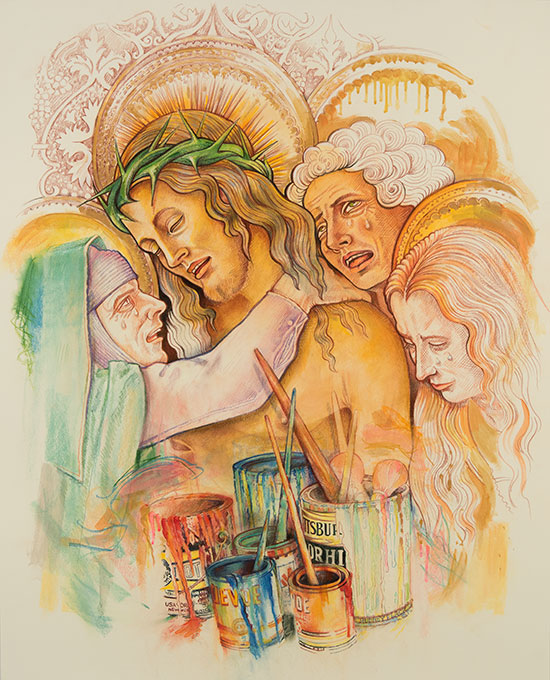
"Pollock's Cans" by Audrey Flack, 2016. Mixed media on paper, 40 x 32 inches. Courtesy of the artist and Hollis Taggart Galleries.
.
My advice to viewers is to look beyond the humor that pervades much of the work. Stay with it and try to absorb the unfamiliar continuity that emerges through the screen of Flack’s oddball wit. Here is something rare in our current and still seminal revival of figurative painting, an approach to content that spares the viewer the usual arm-twist of irony that any proximity to residual historical sentiment seems to demand of the contemporary artist. This is not to say that Flack’s icons and heroines are totally free of ironic tilts. To be fair, there is plenty of goofy subtext—cupcakes, glitter, Baroque putti flinging doughnuts on the proceedings—yet Flack’s overall strategy is to rescue the viewer from the modern and frankly aberrant discomfort with allegory and sentiment.
The largest piece in the show, a near eight-foot-square canvas with the Latinate title “Fiat Lux,” 2017, or “Let There be Light,” involves a group of female and male figures, all but two taken from a 17th century printer’s version of Peter Paul Rubens’s “Garden of Love.” In choosing Christoffel Jegher’s linear woodcut rather than the original painting, Flack invites the viewer into an unfamiliar conduit through which the Baroque has been reincarnated into the modern comic book. It sounds far-fetched, but viewers who give it some thought will begin to appreciate how comics are just about the only place in our new century where allegorical figures can hold their ground without excusing themselves with a nod and a wink to the very contemporary bias against any form of sentiment.
.
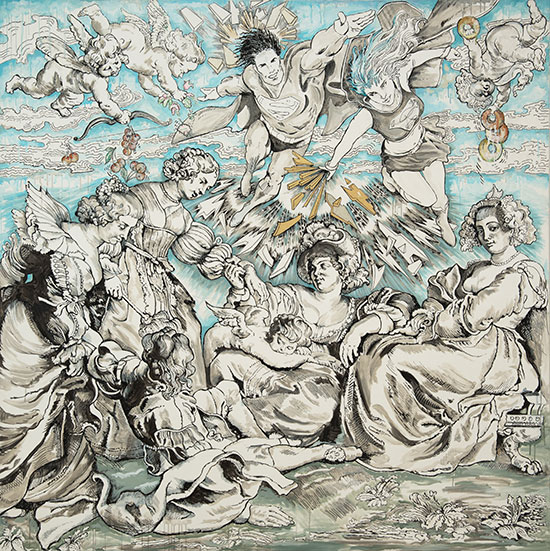
"Fiat Lux" by Audrey Flack, 2017. Acrylic on canvas with 22k white and yellow gold leaf and sparkles, 83 x 83 inches. Courtesy of the artist and Hollis Taggart Galleries.
.
Flack seems determined to disabuse the viewer of this bias. With her sparkling heroines and melodramatic victims, she continues her career-long realignment of the rich allegorical tradition provided by Western art history in a contemporary pursuit of feminist concerns. “Fiat Lux,” for one example, is organized around the trio of women in the Rubens canvas who keep their own counsel amidst surrounding flirtations. By isolating them from the original composition, their independence is reinforced, opening the scene to the unexpected Supergirl flyover, followed at some distance behind, significantly, by her better-known male counterpart.
Flack instinctively locates a sort of irreverence in the Baroque that is typically associated exclusively with a modern sensibility. Because Rubens worked closely with Jegher on his printmaking activities, Flack suggests Rubens must have approved the added male figure and his bawdy contact with his female counterpart. In Flack’s interpretation, the master of the High Baroque was occasionally willing to deconstruct the often preposterous histrionics that made his career. It should not come as a surprise that an artist would pick up on such an unorthodox reading, and it is what makes the inclusion of two eminent historians in the exhibition catalog a shrewd choice.
Robert C. Morgan, in his accompanying catalog essay, “Master Drawings and the Art of Cupcake Angels,” recognizes this same issue and addresses it from a historian’s perspective:
“In a sense, one may suggest [Flack’s pieces in this exhibition] are both Baroque and Pop, and in some cases, leaning heavily toward kitsch. Even so, the carefully orchestrated maneuvering between these attributes is capable of inciting a curious, if not provocative hilarity. This further implies the possibility of common ground between early Baroque and Pop that transcends the methodological approach to art history as a static, learned enterprise.”
In Flack’s easy iconography, kitsch functions in synch with the theatricality of the Baroque. Flack’s transcendence is achieved by humor but undergirded by sentiment that is genuine, not facetious or ironic. Her Marilyn Monroe and her Camille Claudel are not meant as camp; they are presented as genuinely tragic figures.
In the extensive catalog interview that historian John Wilmerding conducted with the artist, he too found this idea intriguing, as in this reaction to Flack telling him that she once had a job inking Spiderman:
“You’re not necessarily looking at Lichtenstein doing the cartoons, you were doing the cartoons directly? But again, that’s a kind of currency in contemporary painting. To me, it’s a lovely way of placing some of these images halfway between Renaissance inscription and contemporary comic book, bubble expressions and narrative bubbles.”
Wilmerding understands that Pop Art generalities are in this instance slightly beside the point. Flack’s connection to the past is direct and not of a piece with Warhol or Lichtenstein.
Most of the work is mixed media on paper, with an emphasis on drawing. “Melencolia,” 2017, introduces Albrecht Dürer’s glum and overly-garbed young lady to a ripped Wonder Woman, whose pouty stare echoes Camille Paglia’s unapologetic embrace of power glamor. “St. Teresa, AHHH OH OH oh,” 2014, frames the artist’s drawing of Bernini’s compromised nun with a dark nimbus and a cartoon-lettered vocal expression to match her physical state, accompanied by a phallic lipstick. A related piece entitled “Cupcake Angel Splash,” 2014/2017, is constructed from a rendering of the angelic face of St. Teresa’s arrow-bearing messenger, complete with glittered comic lettering directly below a cherry-topped cupcake.
.
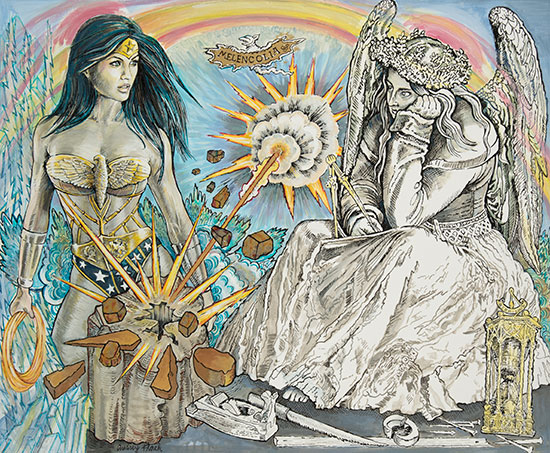
"Melencolia" by Audrey Flack, 2017. Mixed media on canvas, 33 x 40 inches. Courtesy of the artist and Hollis Taggart Galleries.
.
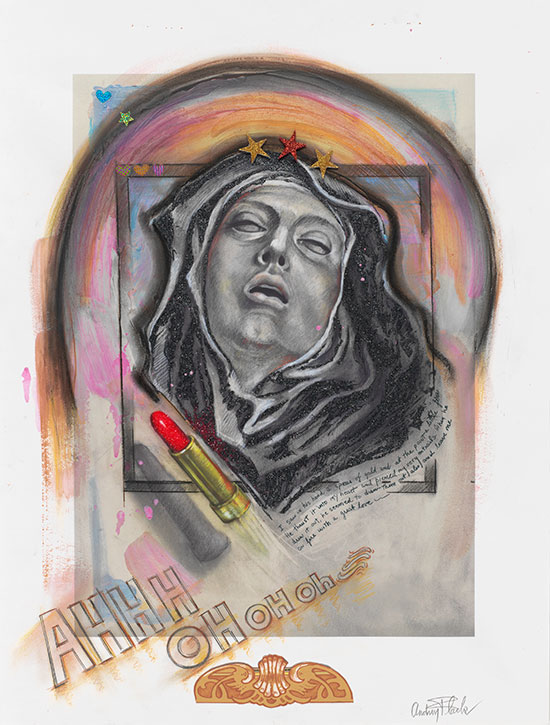
"St. Teresa AHHH OH OH oh" by Audrey Flack, 2014. Digital pigment print with mixed media, 29 x 22 inches. Courtesy of the artist and Hollis Taggart Galleries.
.
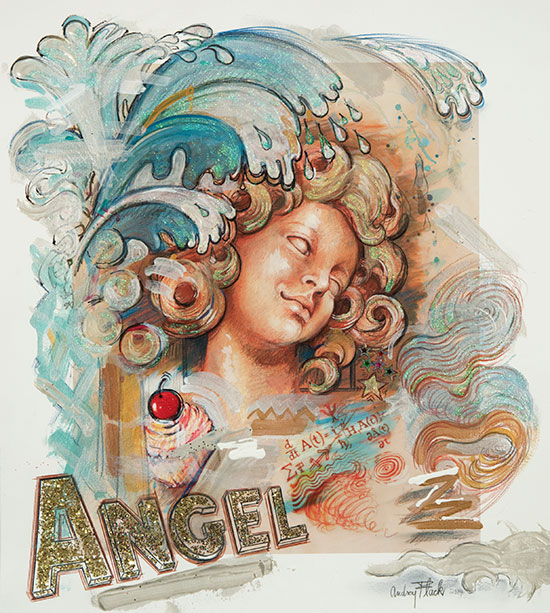
"Cupcake Angel Splash," by Audrey Flack, 2014/2017. Digital pigment print with mixed media, 20 7/8 x 18 1/2 inches. Courtesy of the artist and Hollis Taggart Galleries.
.
In a few comics today, or comics from the last century, art lovers will find visually heroic figures, theatrical gestures, dramatic foreshortening, all the visual properties many thought perished at the outset of modernism. For Flack there is no break with the past, and this exhibition is a celebration of that insight.
___________________________
BASIC FACTS: “Audrey Flack: Master Drawings from Crivelli to Pollock” is on view April 20 through May 26, 2017, at Hollis Taggart Gallery, 521 W 26th Street, New York, NY 10011. www.hollistaggart.com
___________________________
Copyright 2017 Hamptons Art Hub LLC. All rights reserved.

SHE is a philistine, attempting to make us all snicker at the mysteries of the geniuses who gave Beauty to the worlf, and make us ,laugh at it and thereby numb us to real ART that STILL moves us all!: I hate people like this who USE great art and try to be “clever”,and “avant-garde”, , and they HAVE to do that because no great art lives within them, themselves, and they know it.